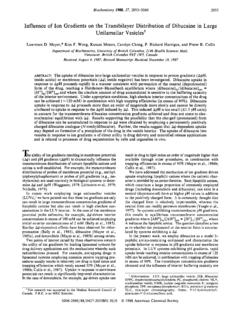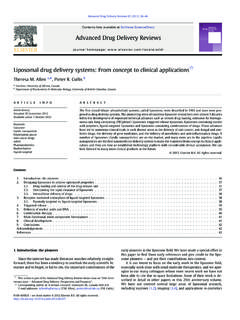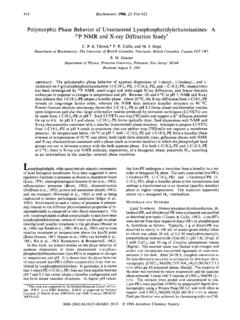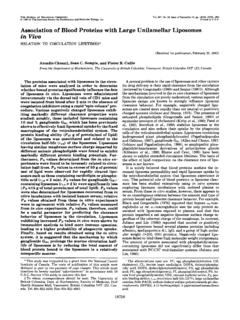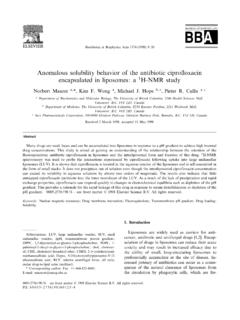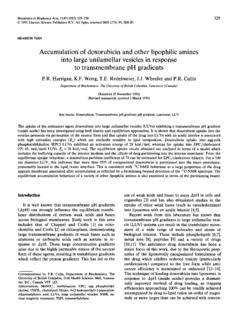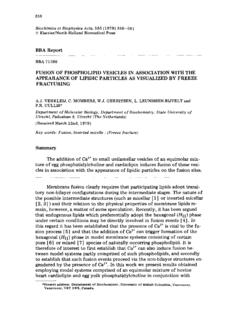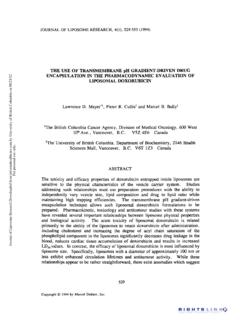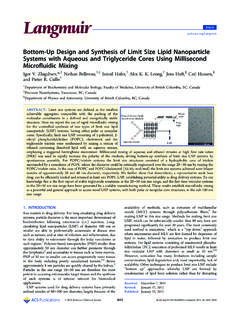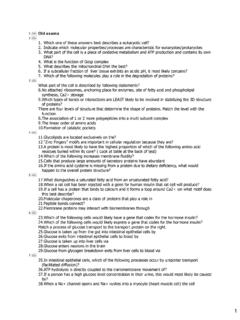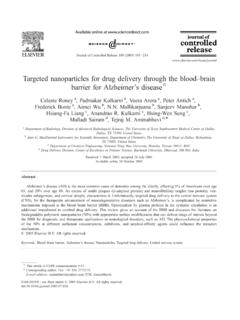Transcription of Protein-liposome conjugates with defined size distributions
1 Biochimica et Biophysica Acta, 1028(1990) 73-81 73. Elsevier BBAMEM74971. Protein-liposome conjugates with defined size distributions H . C . L o u g h r e y 1, K . F . W o n g 1, C h o i 2, P . R . Cullis 1,2 a n d M . B . B a l l y 2. 1 The Unioersity of British Columbia, Faculty of Medicine, Department of Biochemistry, Vancouver, and 2 The Canadian liposome Co. Ltd., North Vancouver, (Canada). (Received2 January 1990). (Revisedmanuscript received15 May 1990). Key words: protein -liposomeconjugate; Streptavidin; Biotin; Vesicleaggregation; Liposomepreparation; Freeze-fracture Conjugation of protein to liposomes by two coupling protocols is shown to result in vesicle aggregation. The degree of aggregation is directly related to the levels of protein conjugated to the liposomes. In an attempt to develop a method of generating stable, homogeneously sized protein -conjugated vesicles, highly aggregated liposome - protein conjugates were extruded through filters of defined pore size .
2 The extrusion procedure is shown to allow the efficient production of Protein-liposome conjugates of defined size distributions , with no loss of protein binding. The extruded samples are relatively stable with respect to size and are easily prepared for various protein to lipid ratios. liposome size has been shown to be a major factor in determining the in vivo blood circulation times of liposomes. A corresponding, significant enhancement in the blood circulation lifetimes for extruded versus aggregated streptavidin- liposome conjugates is observed. Furthermore, the stability of streptavidin- liposome conjugates in vivo was shown by the binding of biotin to iiposomes isolated from plasma 1 and 4 h post-injection. In conclusion, extrusion of, the aggregated systems obtained on coupling proteins to liposomes provides a convenient and general method for generating homogeneously sized Protein-liposome conjugates .
3 Introduction conjugates to bind and deliver liposomally encapsulated materials to cells (reviewed in Refs. 1, 10 and 11). Numerous techniques for the conjugation of proteins In this study we demonstrate, by two physical tech- to liposomes have been developed over the last decade niques, that the attachment of protein to liposomes by (for review see Refs. 1-3). These protein liposome con- various coupling protocols results in vesicle aggregation. jugates have been utilized for a variety of purposes such The amount of liposomally attached protein was shown as the targeting of drugs via immunoliposomes [4-6], to determine the extent of vesicle cross-linking. We diagnostic protocols [7,8] and liposomal vaccines [9]. report a novel method for the generation of protein - These studies emphasize the requirement for a general liposome conjugates with defined size distributions , ob- technique of coupling proteins to liposomes.
4 Particular tained by the extrusion of protein -coupled vesicles areas of interest concern optimization of the coupling through filters of defined pore size . This procedure efficiency, the stability o f the cross-link between the provides a relatively gentle method of producing pro- protein and liposome and the in vitro capabilities of the tein- liposome conjugates of stable size . No significant denaturation of the attached protein is observed. with regard to developing protein coupled liposomes for in vivo applications, the influence of the size of protein - Abbreviations: SMPB, N-succinimidyl-4-(p-maleimidophen- yl)butyrate; SPDP, N-succinimidyl-3-(2-pyridyldithio)propio nate, liposome conjugates on blood clearance behavior was MPB-DPPE, N-(4-(p-maleimidophenyl)butyryl)dipalmit oylphospha- investigated in mice. The results indicate that the size of tidylethanolamine; CHOL, cholesterol; HBS,25 mM Hepes, 150 mM the conjugate is a major factor determining the circula- NaCI (pH ); DTT, dithiothreitol; biotin EPE, biotin egg phospha- tion of liposome conjugates .
5 Tidylethanolamine; Epps, N-(2-hydroxyethyl)piperaTine-N'-3-pro- panesuiphonic acid; Mes, 2-(N-morpholino)ethanesulphonic acid;. Hepes, N-2-hydroxyethylpiperazine-N'-2-ethanesu lphonic acid; Materials and Methods QELS, quasi-elastic light scattering. Materials Correspondence: Bally, The Canadian liposome Company, Suite 308, 267 West Esplanade, North Vancouver, , V7M 1A7, Egg phosphatidylcholine (EPC), and dipalmitoyl- Canada. phosphatidylethanolamine (DPPE) were obtained from 0005-2736/90/$ 1990 ElsevierSciencePublishers (BiomedicalDivision). 74. Avanti Polar Lipids. Biotin egg phosphatidylethanol- Preparation of proteins for coupfing amine (biotin EPE), N-succinimidyl-3-(2-pyridyl- Streptavidin (10 mg/ml in HBS (25 mM Hepes, 150. dithio)propionate (SPDP), N-succinimidyl 4-(p-male- mM NaC1, pH )) was modified with the amine reac- imidophenyl)butyrate (SMPB) were obtained from tive reagent, SPDP according to published procedures Molecular Probes.
6 Streptavidin, FITC-cellite, N-ethyl- [16]. Briefly, SPDP (25 mM in methanol) was incubated maleimide, dithiothreitol (DTT), cholesterol, fl-mer- at a 10 molar ratio to streptavidin at room temperature captoethanol, N-(2-hydroxyethyl)piperazine-N-3-pro- for 30 min. To estimate the extent of modification, a panesulphonic acid (Epps), 2-(N-morpholino)ethanesul- portion of the reaction mixture was passed down Seph- phonic acid (Mes), N-2-hydroxyethylpiperazine-N-2- adex G-50 equilibrated with HBS to remove unreacted ethanesulphonic acid (Hepes) and Sephadex G-50 were SPDP. The extent of modification of streptavidin was obtained from Sigma. Anti-human erythrocyte IgG was determined by estimating the protein concentration at obtained from Cappel and Sepharose CL-4B from 280 nm (molar extinction coefficient at 280 nm (c280): Pharmacia. [14C]Cholesterol and [3H]cholesteryl hexa- ) prior to the addition of dithiothreitol (DTT).
7 Decyl ether were obtained from NEN. [3H]- and [14C] and the 2-thiopyridone concentration at 343 n m (~343: biotin were obtained from Amersham. Female D B A / 2 J 7550) 10 min after the addition of D T r (25 mM). The mice (6 weeks of age) were obtained from Jackson remainder of the reaction mixture was reduced with Laboratories. DTT (25 mM, 10 min) and the thiolated product was isolated by gel exclusion on Sephadex G-50 equilibrated with 25 mM Mes, 25 mM Hepes, 150 mM NaC1 (pH. Synthesis of N-(4-(p-maleimidophenyl)butyryl)dipalmit oyl- ). The product was immediately used in coupling phosphatidylethanolamine (MPB-DPPE) experiments. In the case of IgG (20 mg/ml in HBS;. MPB-DPPE was prepared by a modification of the ~280 105), following the modification of the pro- method of Martin et al. [12] as previously described tein with SPDP, the protein was fluorescently labelled [13].
8 Briefly, MPB-DPPE was synthesized by reacting with FITC-cellite (50% weight of IgG in 150 mM NaC1, DPPE (69 mg) with SMPB (65 mg) in chloroform (5 ml) M NaHCO 3 (pH ), 20 min). Prior to the treat- containing triethylamine (10 mg) at 40 C. After 2 h, ment of the protein with DTT, the sample was sep- TLC on silica showed conversion of DPPE to a faster arated from unreacted reagents on Sephadex G-50 equi- running product (solvent system: chloroform/metha- librated with an acetate buffer (100 mM NaC1, 100 mM. nol/ acetonitrile/water (75:16 : 5:4, v/v); Rf ). The Na acetate (pH )), to protect against the reduction of solution was diluted with chloroform (10 ml) and washed the intrinsic disulphides of the molecule. The sample several times with NaCI ( ) to remove by-products was concentrated to 5 mg/ml by dehydration with of the reaction. The solution was further concentrated aquacide prior to coupling experiments.
9 The extent of in vacuo and the solid residue was triturated and re- modification of streptavidin was 5-6 SPDP molecules crystalized from diethylether to remove unreacted per protein while the modification of the antibody SMPB. Further recrystalization from diethyl ether/ preparation resulted in 2-3 molecules of SPDP per acetonitrile yielded a pure product as indicated by protein . 1H-NMR analysis (Bruker W40, 400 MHz) and low resolution mass spectroscopy (KRATOS MS 50). Coupling of proteins to liposomes The coupling of proteins to liposomes was performed by incubating the reduced PDP-modified protein with Preparation of liposomes liposomes (54 mol% EPC, 45 mol% cholesterol, 1 mol%. Large unilamellar liposomes were prepared as de- MPB-DPPE, sized through filters of 50 or 100 nm pore scribed by Hope et al. [14]. Briefly, appropriate amounts size ), at a ratio of 100 #g protein //xmol lipid (5-30 mM.)
10 Of lipid mixtures in chloroform were deposited in a tube final lipid concentration) at pH as described and dried to a lipid film under a stream of nitrogen elsewhere [13]. The reaction was quenched at various followed by high vacuum for 2 h. Lipid was then times by the addition of N-ethylmaleimide (500 molar hydrated in 25 mM Mes, 25 mM Hepes, 150 mM NaC1 ratio to protein , methanol stock). For in vivo experi- (pH ) and extruded through two stacked 100 nm or ments, samples were further quenched with fl-mercapto- 50 nm filters ten times. Prior to coupling experiments, ethanol (10 molar ratio with respect to N-ethylmalei- samples were titrated to pH with NaOH. Lipid was mide) after a 2 h incubation of the reaction mixture estimated either by the colorimetric method of Fiske with N-ethylmaleimide. Uncoupled protein was re- and SubbaRow [15] or by incorporating trace amounts moved by gel filtration on Sepharose CL-4B equi- of [14C]cholesterol or [3H]cholesteryl hexadecyl ether in librated with HBS.
